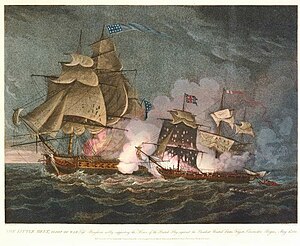Little Belt affair
This article's lead section may be too short to adequately summarize the key points. (February 2021) |
| Little Belt affair | |||||||
|---|---|---|---|---|---|---|---|
| Part of the events leading to the War of 1812 | |||||||
 A 16 May 1811 engraving shows USS President battling HMS Little Belt | |||||||
| |||||||
| Belligerents | |||||||
|
|
| ||||||
| Commanders and leaders | |||||||
|
|
John Rodgers | ||||||
| Strength | |||||||
|
1 sloop-of-war 20 guns |
1 frigate 56 guns | ||||||
| Casualties and losses | |||||||
|
11 killed 21 wounded 1 sloop-of-war severely damaged |
1 wounded 1 frigate slightly damaged | ||||||
| Origins of the War of 1812 |
|---|
The Little Belt affair was a naval battle on the night of 16 May 1811. It involved the United States frigate USS President and the British sixth-rate HMS Little Belt, a sloop-of-war, which had originally been the Danish ship Lillebælt, before being captured by the British in the 1807 Battle of Copenhagen. The encounter took place off the North Carolina coast. The Little Belt Affair was one of many incidents and events that led to the War of 1812.
Background
The Little Belt affair occurred four years after the
Affair
Chase
Battle
The British and American accounts disagree on what followed. As President closed with Little Belt, Bingham thought the frigate was maneuvering to rake his ship with gunfire. Bingham wore ship three times to avoid the threat. The ships were not within hailing range until long after sunset. At about 10:15, each captain demanded the other identify his ship. Each refused to answer before the other. Each captain later claimed he had been the first to ask. Shortly after this a shot was fired, but it is disputed who shot it.[1] The ships were soon engaged in a battle which the sloop had no chance of winning. After fifteen minutes, most of Bingham's guns had been put out of action, and Rodgers ordered a cease fire. President returned and Rodgers asked Bingham if he had struck. Bingham replied he had not, and President withdrew.
Aftermath
President had only one man injured. Little Belt suffered nine dead and 23 injured (two of them fatally). The sloop was also badly damaged in the encounter. The next morning, Lieutenant John Creighton went from President to Little Belt to lament the affair and offer Bingham space at any American port, which he declined. Bingham asked why President had attacked his much smaller ship. Creighton said it was because Little Belt had "provoked" the action. Bingham rejected the charge.

President sailed on to New York City, and Little Belt went to the
On 19 August 1812, after war had finally broken out, HMS Guerriere sailed into her ill-fated action against USS Constitution. Painted across her foretopsail were the words "NOT THE LITTLE BELT".[2][3]
See also
Footnotes
References
- Toll, Ian W. (2006). Six Frigates: The Epic History of the Founding of the U.S. Navy. New York: W. W. Norton. ISBN 978-0-393-05847-5.
- Martin, Tyrone G. (2006). A Most Fortunate Ship: A Narrative History of Old Ironsides. Annapolis, Maryland: Naval Institute Press.
- Naval Chronicle, Vol. 26, pp. 37–38
- Naval Chronicle, Vol. 27, pp. 57–58
